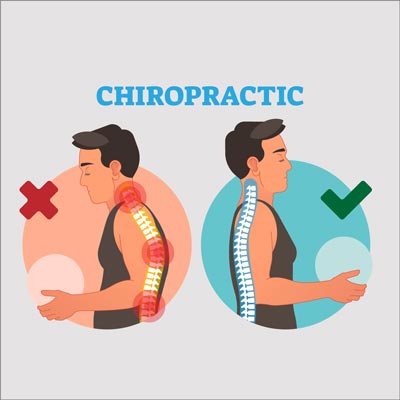Short Term vs. Long Term Chiropractic Care: Here Are The Differences You Need to Know

Many people end up in a chiropractic office as a last resort, tired of struggling with chronic or acute pain, poor posture, migraines, or other conditions that did not respond to traditional medical treatment. While chiropractic care has an array of lesser-known functions and benefits, it is primarily recognized as a treatment for the bones and joints, and is often sought to treat ailments of the musculoskeletal system. This includes joint and muscle pain, strain and weakness in the tissues and muscles, and poor posture. One of the most influential factors on how effective chiropractic care can be is the duration and regularity of treatment. There are two general approaches to treatment: short term vs. long term chiropractic care. Here are the differences you need to know.
Short Term Chiropractic Care
Short term chiropractic care is a treatment plan that is designed to last for only a short duration of time. This could be as few as one to two visits, or simply a brief, intensive treatment plan that is intended to last from a series of weeks to a month.
Short term chiropractic care may include a variety of treatments and interventions, depending on the condition being treated. Although the duration of treatment is not comparable to long term chiropractic care, the same types of treatments may be used. These treatments may include spinal compression, traction, chiropractic massage, the use of laser or ultrasound technology, at-home exercises, postural correction, the use of a customized brace, transportable tools to supplement treatment out of the chiropractic office, and more.
Why might someone seek out short-term chiropractic care?
While chiropractic care is most effective for resolving a wide variety of conditions when it is received consistently and frequently, short term chiropractic care can still be a very effective means of treatment for certain conditions and situations.
#Acute Injury
Are you experiencing an acute injury that has just occured as the result of an accident or injury? Are you looking for a car accident chiropractor in Alameda as the result of a traffic collision, possibly resulting in whiplash or some other acute injury leading to pain or discomfort?
Acute injuries often respond well to short term chiropractic care, and in some cases, short term care is all that is required for the body to receive a jump-start in its healing process.
Acute injuries can include sprains, strains, and tears of the muscle and tissue, concussions, dislocation and fractures, and will often be accompanied by inflammation, pain, discomfort, and fluid build-up.
If left untreated, an acute injury can transform into chronic pain. Oftentimes, untreated trauma to the back, neck, and extremities develops into chronic discomfort, throbbing, aching, and sharp pain that then require a different kind of treatment.
It’s important to seek care for acute injuries immediately. Depending on the nature of the injury, it’s possible that a short term treatment plan may be sufficient to help resolve inflammation and pain, support healing, and retain range of motion, flexibility, and mobility as the affected area returns to health.
#Supplemental Care
Are you already receiving treatment for a condition, disease, or symptom? Are you looking for an Alameda chiropractor to provide additional care to an already comprehensive treatment plan? Chiropractic care plays well with other forms of care, and in most cases, helps to increase the healing capacity of the body, maximizing the effects of other treatments.
If you’re already receiving another form of medical or alternative treatment (or both), chiropractic care can still provide valuable benefits. For this reason, chiropractic care can be considered a short-term form of care intended to supplement and support other modalities of treatment.
This might be seen in instances where an individual is in the process of treating an acute or chronic illness, disorder, or infection. Examples of common conditions for which one might seek chiropractic care as a supplemental form of care include cancer, pneumonia, bronchitis, autoimmune distress and symptoms of physical imbalance resulting from injury rehabilitation.
Short Term Care – Bottom Line
If you’re experiencing an acute physical event that is anticipated to resolve quickly, short term chiropractic care may be exactly what you need to help boost your recovery. Additionally, if you are traveling, in-between regular care practitioners, or find yourself in some otherwise temporary condition, short term chiropractic care can provide support and wellness-boosting effects during transitional periods.
Long Term Chiropractic Care
Long term chiropractic care is a form of treatment designed to last for a specified duration of 6 months or more, or continue indefinitely. This type of treatment plan may include regularly scheduled visits several times a week or month, or singular visits aligned with known events to help provide targeted wellness support.
Like short-term care, long-term chiropractic care features a variety of treatment forms, although these treatments often stabilize into a specific routine of care once an effective form or treatment is determined. Long-term chiropractic care tends to focus on the treatment that has been identified as most effective for the individual’s unique case, which includes all of the same treatments as short term care, customized for individual needs.
Why might someone seek out long-term chiropractic care?
While several conditions and symptoms can be treated with a short and intensive chiropractic care plan—for example, acute conditions like injuries and passing diseases or disorders—many conditions require long-term care to help the wellness of the body over time.
Some conditions are best treated with treatment plans that extend to 6 months or beyond. Oftentimes, individuals commit to lifelong regular chiropractic treatment, once they experience the benefits of frequent care.
Irrespective of the exact duration of time a long-term treatment plan, long-term treatment is one of the best ways to maximize all of the benefits of chiropractic care and get the most out of what chiropractic has to offer.
#Posture Correction
The development of poor posture doesn’t occur overnight, and neither does the posture correction process. While many patients experience an improvement immediately upon treatment, to receive the most transformational and long-term results, regular chiropractic care is significantly more effective than short-term care.
Because the body often reverts to habitual postures and positions, short term care can begin to reverse over time if lifestyle changes are not sufficiently implemented. Long-term care can protect posture improvements and allow the body to learn new habits.
#Pain or Discomfort
Depending on the source and cause of pain and discomfort, short term treatment may not be sufficient to eliminate or significantly reduce it. Pain resulting from an acute injury can often heal rapidly with support, making short-term treatment appropriate, but the longer pain and discomfort has been present, the more likely it is to require lengthy treatment interventions to ensure that affected areas are sufficiently repaired.
When pain is present for a long period of time—for example, chronic back pain that often lasts for months or years—microdamage can occur to the surrounding tissue. If you’re looking for back pain relief in Alameda, CA, it’s likely that the pain has persisted for a significant period of time. This may be because of postural misalignment, bruising of the nerves, or chronic strain to surrounding muscles. These factors can cause damage that is best treated with long-term care to ensure that posture can be corrected, nerves can recover, and muscles can build strength in an improved postural position.
#Headaches and Migraines
If you’re looking for migraine relief chiropractic in Alameda, CA, it’s possible that there are some postural issues that are compromising the circulation of nerve energy from your spinal cord to your brain. When this occurs, migraines and headaches can become a chronic problem that is difficult to relieve.
Chiropractic treatment can often provide immediate relief for migraines and headaches, but if the underlying issue is the result of misalignment in the spine, the relief may be temporary. For this reason, long-term treatment is preferred.
#Heart or Respiratory Disease
Depending on the kind of heart or respiratory condition being treated, chiropractic treatment may be best approached as a form of long-term care. Chiropractic can help to boost the function of the cardiovascular and respiratory systems, and in instances where function is chronically strained or requiring extra support, can be a valuable form of regular treatment.
Examples of these kinds of conditions include chiropractic care for coronary heart disease, arrhythmia, valve disease, high blood pressure, congenital or inherited heart conditions, enlarged heart, asthma, emphysema, COPD, cystic fibrosis, and sleep apnea.
#Other Chronic Conditions
Chronic conditions that are not expected to abate or go away are excellent candidates for long-term chiropractic care.
Long Term Care – Bottom Line
Ultimately, the choice between long-term and short-term chiropractic care is going to be determined by the condition or symptoms that you are currently experiencing.
Some conditions may require a mix of both short-term and long-term care to be fully effective. The decision to select one form of care over another is best made with your expert Alameda chiropractor.
At Symmetry Health Center, we believe in working with every single patient to determine the best approach for their unique case. In collaboration with you, we are proud to deliver the most effective chiropractic care in Oakland and Alameda, CA. Book your appointment now.
